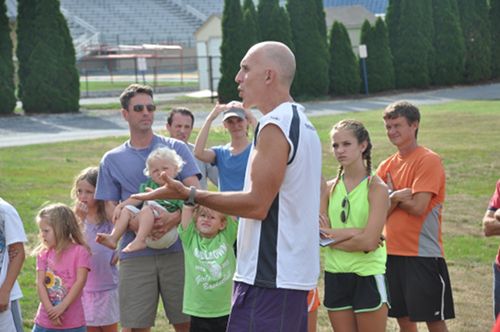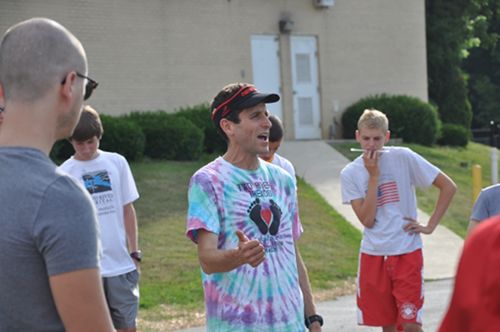A man’s errors are his portals of discovery - James Joyce
Shepherdstown, West Virginia was honored to host and gain wisdom from New York Times Best Selling author Christopher McDougall in May 2010 and again in May 2011. Chris and I both share a similar pathway in the discovery of better health through healthier movement. He is now a world famous author, and I am a physician in a small town. We both are in our mid 40’s, have run our whole lives in play or competition, and have trashed our feet along the way.
Chris’s best seller Born to Run follows the story of “why does my foot hurt?”. It starts with the usual trips to the doctor, shoe store, and orthotic makers. With each escalation in care there was more pain…so he chose a different route. Go to the Copper Canyon of Mexico where the Tarahumara Indians run hundreds of miles in sandals happily into their 80’s. He returned from the trip well in mind and body. The book is a must read not only for runners, but for anyone wishing to have a pain free life on two feet.

I began running barefoot on the beach as a pre-teen and easily covered distances of 10 or more miles. My path of pain began in high school and then into a college and post collegiate running career. I had successes which were often tempered by injury, setbacks, surgery. I had acquired a closet full of arch supports, orthotics, various shoe types…all in search of the holy grail of pain free running. Pushed through the pain in pursuit of the Olympic Trials 2:22 standard and came within 2 minutes on 2 occasions. By the year 2000 at age 34 my first toe joints were fused with arthritis and had a surgical procedures to reduce the pain. The medical advice...”you are done with running”. Wish I knew then what I’ve learned in the last 10 years.
Like Chris’s voyage to Mexico, my voyage of discovery began with watching Kenyan barefoot movement and applying this to easy jogging. I learned how to run softly without pushing off. 7 months after surgery and with a new efficient and painless running stride I ran a 2:28 for 3rd place in the Marine Corps Marathon, only 4 minutes shy of my best time ever for the distance.
In 10 years the learning has deepened into a larger practice of discovery into all aspects of movement and how the foot interacts with the ground. The methods of East African running were difficult to explain to others until a book called Chi Running was written in 1995. Fascinated by how author Danny Dreyer taught this and seeing wider implications, we agreed to study the method. Our results on injury prevention have been presented at National and International Conferences and even won first place research at large military conference on public health. There are 10’s of thousands of Chi Runners now throughout the world all aware of and spreading the word that we are designed to run.

The Tarahumara Indians run in a style reflective of Chi - they land lightly on their mid-foot (not the heel), have a slight forward lean, and are completely relaxed and happy. After learning better running technique, Chris discovered during his Mexico adventure that the best shoe was less shoe. The Tarahumara wear flat rubber sandals.
My enlightenment into the affects of shoes was not as immediate as Chris, who experienced it by cultural immersion. The real innovators in shoe design understood the principles of movement and how shoes affect gait. In 2007 I worked with a company called Velocy who were designing a Forward Gravity Shoe. The shoe complemented a gait where you did not heel strike but was too unusual for the general public. While competing for Brooks in 2007-9, a lead designer there had me cut a centimeter off the heel of his favorite designed shoe. This to him was the perfect shoe - flat from toe to heel. Most running and walking shoes have almost an inch of heel elevation. Although it felt a bit strange at first, after a week I felt perfectly aligned and could not go back to an elevated heel. We worked together on a flat sandal to train runners in better gait, had it protoyped, but the market was not ready for this “unusual” thought of making shoes do less and the foot do more. (These prototypes are available to see at Two Rivers Treads).
Every study performed in runners and walkers shouts at these principles, but culture and marketing have suppressed them. The arches of your foot and positions on bones and tendons have support and stability only when flat to the ground, maybe that is why we evolved the way we did. Mess with the structure and it weakens. Stand in your barefeet and push your big toe into the ground, soften your knees, now pick up the opposite foot. This is how the foot works to stabilize you. The flexor tendon of the large toe is activated and the 5th metatarsal (small toe side) is on the ground, also providing a stable base.
Walt Whitman wrote “The press of my foot to the earth springs a hundred affections”. He understood the magic too of your feet feeling the ground. Paradoxically the more pillowy cushion, the less you feel the ground, and the more impact on your structure. Everything upstream muscle wakes up when the 200,000 nerve ending in your feet can feel, adapt, and react. This is why gymnasts, acrobats, and dances never wear cushioned and supportive shoes.
The two companies that really get this are Newton Running and Terra Plana Vivo Barefoot. The leaders of both of these companies have their own amazing stories of discovery and are now taking on the giants of the industry… and succeeding one walker and runner at a time. The teaching is all about what your bare foot does, and if you need shoes than design something that does not get in the way.
Chris and I both agree that it is not about the shoes (or lack thereof), but more about understanding how your body stands and moves, improving strength and function, and then figure out what shoe (if any) to wear. 10 years after surgery and being told not to run, I’m finally putting the puzzle together. Finished the Boston marathon this year in 2:37:00 smiling the whole way in my Newtons. I have run under 2:35 for a marathon 22 of the last 24 years, and under 2:40 24 of those years; missing only my medical intern year (no time to find a race).
If you choose to free yourself of traditional opinion and practice, you will likely resign from the “well heeled” club too.
Our most enlightening moment our day with Chris was during a book talk at Mellow Moods . We spent together talking to runners, listening, and teaching . Charles Radi of Frederick shared a story of his bad painful running experience and posted on Facebook “The human body in not designed to run”. A friend replied “….I guess you haven’t read “Born to Run””. Two weeks later after reading the book twice he finished a 26 mile marathon and now has confidence he will run pain free forever. (go to min 2:15 of this video...)
It is not “No Pain, No Gain”, but rather “No Pain….Thank You”.
I try to spend as much time as possible totally barefoot now, feeling the ground, activating nerves and muscles that would be at rest if not for the communication with the ground. I do almost all my daily running barefoot now on grass and pavement. I love my light and flat Newton Racers for road races and VivoBarefoot casual for other work activity to get me secretly barefoot at my day job as a physician.
I commend other NYC Barefoot Run kudus for their bold and encompassing works on the barefoot running topic - from anatomy, to biomechanics, supplemental training, and step by step gait instruction. They are leading the extensive work now coming together by leads in the science and running community.
Come learn more and try on some flat shoes at Two Rivers Treads – A Center for Natural Running and Walking in Shepherdstown.
Visit the Natural Running Center to start your journey of discovery.
